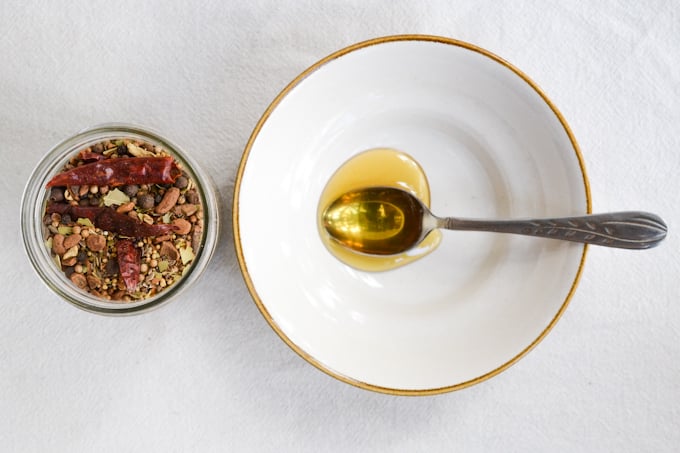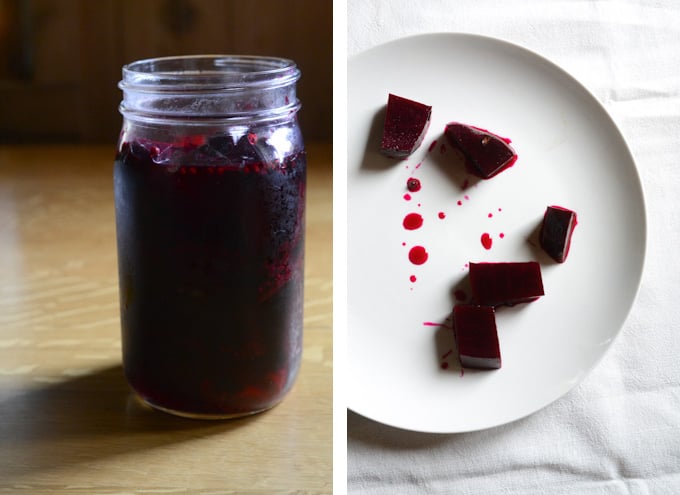Guest Post: Pickled Beets with Honey from Camille Storch
Oh friends, do I have a treat in store for you today! It’s a guest post from writer, woodworker, avid canner, and mom of two, Camille Storch. She writes about ecology, agriculture, community, and the reality of her family’s joyful, off-the-grid life in rural Western Oregon on her blog, Wayward Spark.
She also designs and crafts natural edge cutting and serving boards and sells them in her Etsy shop, Red Onion Woodworks. I recently added one of her boards to my kitchen and it’s quickly become one of my most loved and used tools. Enjoy!
My mom canned a lot when I was a kid, but like most activities my parents enjoyed, I had no interest in participating in her steamy kitchen exploits. My parents were big gardeners/small farmers who sold their vegetables and baked goods at the local farmers’ market starting the year I was born (and continuing to this day). I enjoyed hanging around the action of the market, and I always loved to eat pretty much any kind of fruit or vegetable, but I never once sowed a seed or pulled a weed unless I was coerced or bribed into doing it.
In a strange and unexplainable turn of events, I got my first real job when I was still in high school working on an organic vegetable farm, and even more surprisingly, I really liked it. I tackled thistles, harvested sweet cherries, and cleaned fresh garlic for days on end. I got a couple of gnarly sunburns, I learned to speak Spanish, and for the first time in my life, I developed real working muscles. And my love for fruits and vegetables reached a whole new level.
When I moved out of my parents’ house at 18, I would regularly eat giant piles of kale (before kale was the phenom that it is today) over brown rice for dinner, and in the summer, I’d feast on unmarketable-but-still-delicious cracked heirloom tomatoes out in the fields with sprigs of basil as chasers. Farms and food became a way of life for me during my college years, and I’d show up to class in dirty Carhartt’s, like they were some sort of badge of honor.
My first forays into canning on my own involved farm excesses including ugly tomatoes, windfall apples, and a whole box of scarred nectarines that couldn’t be sold. I spent a fair bit of time on the phone with my mom or tracking down USDA hot water bath guidelines, but it wasn’t long before the rhythm of washing, sterilizing, peeling, stuffing, lidding, and boiling was familiar and comforting.
I moved into a rental house with a new roommate in May at the end of my junior year in college, and I saw my roommate’s eyes grow wide as I schlepped box after box of empty canning jars up the steps and into the kitchen. A month later, I bought my first chest freezer and moved that into the house, too. I’m fairly certain my roommate thought I was completely off my rocker, but by the end of the summer, I had canned, frozen, or dried enough produce to feed a small army.
Over the years, I’ve pared down my canning experiments to include more or less just what my family can and wants to eat in the off season: a few jars of jam, some applesauce, a lot of cold-packed whole tomatoes, and a few extras just for fun or for gifts (plus a freezer full of blueberries and other staples). The fact that canning and preserving is really “in” right now is kind of funny to me because it’s been a part of my own life for so long now that it doesn’t feel too special anymore. That said, I’m all in favor of any activity that brings folks closer to their food and the farms that produce that food.
When I stumbled across this new fangled group called the Portland Preservation Society on Instagram, I was intrigued. When I went to my first meeting, I was hooked. The PPS is a loose collective of Portland area food enthusiasts that meets monthly to swap (mostly canned) food items. (Be sure to check out PPS founder Brooke Weeber’s crazy cool vegetable illustrations in her Etsy shop, Little Canoe.) Every meeting is a showcase of the possibilities in food preservation from jellies to pickles to spreads to infused alcohols, sweet and savory alike.
The April PPS meeting was the perfect excuse for me to dust off my trusty pickled beet recipe. I first ordered a big bag of beets from my vegetable alma mater, Gathering Together Farm, and then I stole a few onions from my parents’ root cellar. I used honey instead of sugar in this recipe because my husband is a beekeeper, so we almost always have honey on hand, and I’m all about keepin’ it local. I spent a pleasant afternoon stuffing jars and perfuming my kitchen with steam from the sweet and tangy brine. In the end, I discovered that my fellow PPS members are just as enthusiastic about pickled beets as I am, but luckily I held back a couple jars to enjoy at home.
There are beet lovers and beet haters in the world, and well, I love ‘em. Pretty much any style of beets suits me just fine, especially if the earthy roots are paired with a bit of creamy chévre or salty feta. These pickled beets are honey sweetened but not overly so and seasoned with onion (cipollini if you can find them) and a bit of pickling spice. The preservative power comes from the all-important ratio of 2 parts vinegar to 1 part water, so if you want to halve or double this recipe, be sure to retain that balance.
Print
Pickled Beets with Honey
Yield: 7 quarts
Ingredients
~10 pounds beets, any size or shape4 small or 2 medium onions
8 cups apple cider vinegar
4 cups water
2 cups honey
1 tablespoon salt
7 tablespoons pickling spice (your own blend or a premixed medley from the store)
Instructions
Sterilize 7 quart jars or 14 pint jars and lids.Peel and slice the onions. Add a handful of onion slices to each jar. Wash the beets, and trim off the beet greens and long roots. Steam the whole beets until fork tender (about 40 minutes). Allow them to cool. Cut the beets into wedges, slices, or bite-sized chunks, and pack them into jars, leaving 1/2" headspace. Add 1 tablespoon of pickling spice to each quart jar (1 1/2 teaspoon per pint jar).
In a medium pot, bring the vinegar, water, honey, and salt to a rolling boil. Pour the brine into the jars, leaving 1/2" headspace.
Wipe the rims of the jars with a paper towel, and screw on canning lids until finger tight. Process in a boiling water bath for 30 minutes (as per OSU Extension Service's guidelines).Schema/Recipe SEO Data Markup by ZipList Recipe Plugin2.2http://www.foodinjars.com/2013/05/guest-post-pickled-beets-with-honey-from-camille-storch/
Related Posts:
Preserves in Action: Baby Arugula with Pickled Beets
Blog Update and Meet the Intern
Guest Post: A First Time Canner Makes Blueberry Jam









